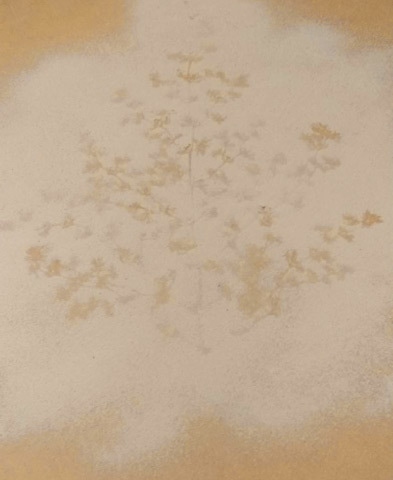
As people grapple with an altered reality and the past year riddled with lockdowns and deaths, the group show Archival Memory curated by Malika Abbas at Gandhara Art helps to put things in perspective.
Its premise presents an apt opportunity to reflect on ways of living and to challenge accepted norms. Sensitively curated, the visuals exemplify diverse practices that blend seamlessly together. From concept to colour palette, the exhibition places the six individual artists’ thinking in relation to the others, addressing relevant notions in a wholesome manner. Two words that resonate with most artists’ work are ‘reimagine’ and ‘transient’.
For Sadia Salim these words manifest in rituals that become inhabited moments of time which allowed her to re-evaluate, re-plan and to reimagine life as we know it — to reconstruct lived realities; an effort to rein back the race that is living in a metropolis city such as Karachi. Her work consists of found natural debris, be it flower buds, broken stalks or dead branches — gathered from all over the world, embodying her travels and history — dipped in clay, immortalised and housed in platters.

Mahreen Zuberi’s work stems from pre-pandemic 2019 days. Analysing the implication of land and ownership, her trajectory began when an Indian jet crossed and crashed into Pakistani territory. Visualised in the piece titled ‘How to Unfold a Paper Plane’, the event prompted her to analyse the nature of land, and how humans conjure the meaning of ownership.
Mariam Agha’s practice addresses expectations of married women in relation to men in society; whether it is qualifying their roles as dutiful wives or bearing male offspring. Agha has attempted to reimagine and change the narrative behind borrowed age-old Urdu/Hindi phrases such as Doodh Ho Nahao Pooto Phalo and Jug Jug Jiyo that have infiltrated Pakistani culture. She pins the origin of these phrases in Hindu culture that tie a woman’s identity to her marital status and are used indiscriminately to date. This is a point of contention for the artist. Agha has four pieces in the show, named after these phrases.

A group exhibition showcases a proposed shift from tradition, imagines new meanings and narratives
Anushka Rustomji’s inspiration comes from hybrid monumental structures found in Eastern Mesopotamia, areas that constitute present day Iran, Iraq and Syria. Her concerns arise from the past year spent in lockdown, addressing our inability to be free, despite being able-bodied. She has found an analogy to this predicament in these fast-disappearing Mesopotamian hybrid monuments.
Her serene visuals belie the conflicting ideas Rustomji endeavours to address. In five of the 10 achromatic pieces titled ‘Fight or Flight’, Rustomji focuses on the wings attributed to the larger-than-life monuments, which are in complete contradiction to their concrete and heavy materiality. Rustomji visualised her ideas in black and white collage. The other five of the 10 pieces are a mirror-image of these collages, made with pin-prick drawings similar to braille.

Onaiz Taji, the only male artist in the group, has five pieces on display. His renderings are not what one expects when you hear the word figurative. Instead of reclining nudes or boisterous forms, he presents a multitude of delicate line drawings of simple, illustrative clothed forms, that pull the viewer in, urging one to glance from one tiny person to another, searching for differences and similarities. Considering his colour palette is mostly neutral, and he wants his drawings to appear as non-objective organic images from afar, his work is powerful and ponderous.
Tucked away in a corner on the top floor is Risham Syed’s jolting installation ‘Texts and Contexts: Raga Sughrai’ (2021). Before entering her space, one is greeted by the sounds of a blaring Raga Sughrai sung by the artist herself.
Much like the fast-paced world of technology and media, where one’s senses and cognition is constantly pulled in different directions, Syed’s work stimulates all senses simultaneously, despite the major part of her piece being a still image of a bygone era: a photo of a vintage ’80s domestic setting. Set before this still projection on the wall, is a laptop playing random bits of seemingly political footage on a loop.
“Archival Memory” is being exhibited at Gandhara Art in Karachi from February 11 to March 11, 2021
Published in Dawn, EOS, February 28th, 2021












































Dear visitor, the comments section is undergoing an overhaul and will return soon.